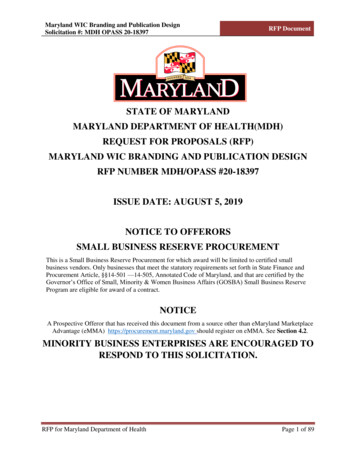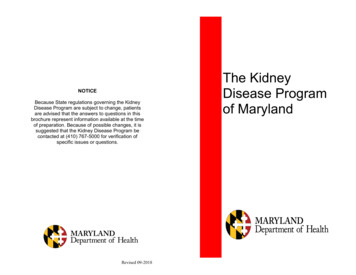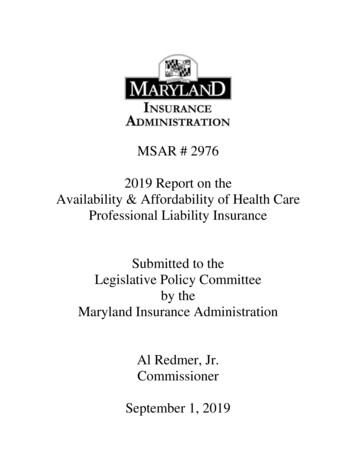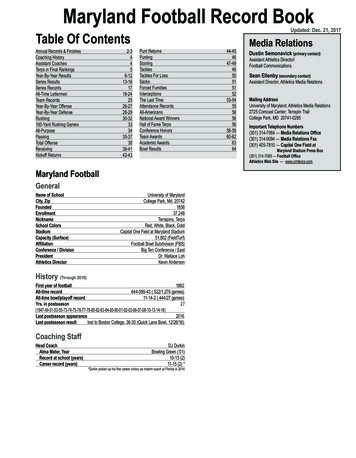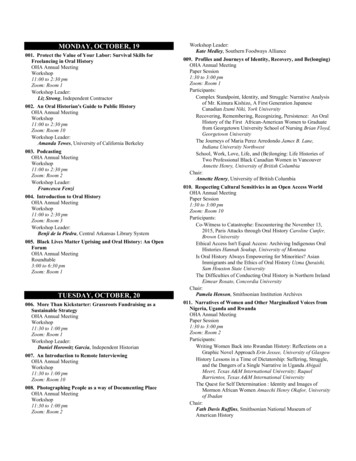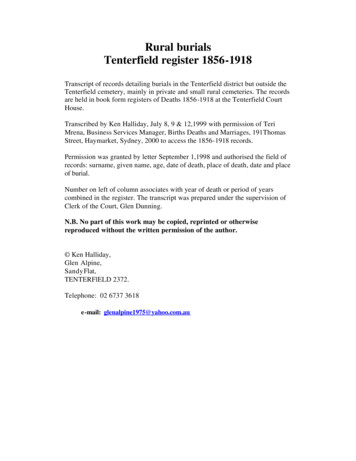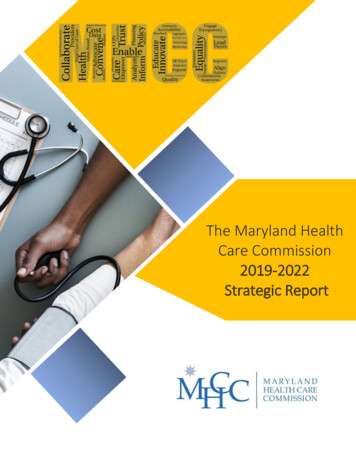
Transcription
The Maryland HealthCare Commission2019-2022Strategic Report
Executive SummaryThe intent of this report is to describe the Maryland Health Care Commission’s (MHCC orCommission) strategic plans for 2019-2022. The Commissioners and MHCC staff developed thesepriorities and objectives during the November 2018 MHCC Strategic Retreat. This plan builds on theMHCC’s past success and aligns with the Commission’s mission, capabilities, and regulatory authority.Maryland’s health care system is in a state of transition with the Total Cost of Care (TCOC) Modellaunching in January 2019. The expansion of value-based payment models will require significantchanges in care delivery and modernization of the State Health Plan to align with the Maryland AllPayer Model. The State’s health care priorities for the next four years include reducing the impact ofthe opioid epidemic, supporting the TCOC Model, and resolving rural and minority health disparities.The MHCC has a track record of driving health advancement throughout Maryland. The Commission’sdata resource and management capabilities make them a key partner for continued systemimprovement. The Commission has identified five priority areas to help the State of Maryland reachits health care goals. These priorities and the corresponding objectives include:Educate, inform, and engage the health care community Educate, inform, and engage the health care community on MHCC activities to elevate thesuccess of the Commissions work in all priority areas.Make MHCC the trusted source of quality and cost information Increase use of MHCC quality and cost data by all members of the State health caresystem, including Maryland residents, to increase price transparency and reduce use oflow-value care.Modernize health planning and the Certificate of Need program Modernize the Certificate of Need Program to minimize administrative burden andsupport the State’s goals under the All-Payer Model.Enable providers to participate in value-based payment models Collaborate with stakeholders to engage specialty groups and facilitate wider adoption ofalternative payment models.Elevate telehealth Expand the use of telehealth services in a variety of health care settings by educatingproviders and patients and evaluating grant programs.2
Table of ContentsCommissioners.4Introduction . 5The MHCC Strategic Plan . 5Maryland’s Health Care Environment . 5The MHCC’s Capabilities. 6The MHCC’s Role . 7The MHCC’s Vision & Mission . 7Everyone’s Challenge: Addressing Social Determinants of Health and Health Disparities. 8The MHCC’s Priorities. 10Educate, inform, and engage the health care community . 11Make MHCC the trusted source of quality and cost information . 13Modernize health planning and the certificate of need program . 15Enable providers to participate in value-based payment models . 17Elevate telehealth . 19Our Strategic Intent . 21This report was created in collaborationwith Discern Health.3
CommissionersRobert E. Moffit, PhD, ChairSenior Fellow, Health Policy StudiesHeritage FoundationAndrew N. Pollak, MD, Vice ChairProfessor and ChairDepartment of Orthopaedics University ofMaryland School of MedicineChief of OrthopaedicsUniversity of Maryland Medical SystemMichael J. O’Grady, PhDPrincipal, Health Policy LLC, andSenior Fellow, National Opinion ResearchCtr (NORC) at the University of ChicagoCandice A. Peters, MDPhysical Medicine and Rehabilitation inPrivate PracticeMarcia BoyleFounderImmune Deficiency FoundationMartha G. RymerRymer & Associates, P.A.Elizabeth A. Hafey, Esq.AssociateMiles & Stockbridge P.C.Randolph S. Sergent, Esq.Vice President and Deputy General CounselCareFirst BlueCross BlueShieldMargaret Hammersla, Ph.D.Senior Director DNP ProgramAssistant ProfessorOrganizational Systems Adult HealthUniversity of Maryland School of NursingStephen B. Thomas, PhDProfessor of Health Services AdministrationSchool of Public HealthDirector, Maryland Center for Health EquityUniversity of Maryland, College ParkJason C. McCarthyVice President of Operations – BaltimoreKaiser Foundation Health PlanCassandra TomarchioBusiness Operations ManagerEnterprise Information Systems DirectorateUS Army Communications ElectronicsCommandJeffrey Metz, MBA, LNHAPresident and AdministratorEgle Nursing and Rehab CenterGerard S. O’Connor, MDGeneral Surgeon in Private PracticeMarcus L. Wang, Esq.Co-Founder, President and GeneralManagerZytoGen Global Genetics Institute4
IntroductionThe MHCC Strategic Planthe launch of the Total Cost of Care (TCOC)Model, further advancing the State’stransition to a value-based system throughexpansion of the Maryland All-PayerModel. 1 The TCOC Model, combined withworld-class providers and public healthorganizations, positions Maryland as anational health care innovator and leader.The following report documents MHCC’sstrategic plan for 2019-2022. The MHCC, inpartnership with Discern Health, developedthe plan following the 2018 MHCC StrategicRetreat held on November 16th, 2018.During the retreat, Commissioners andMHCC staff reviewed past activities,brainstormed potential opportunities, andset priorities for the upcoming years. Theplan also includes input from an onlinesurvey and phone interviews completedbefore the strategic retreat.Despite Maryland’s leadership status indelivery system reform, opportunities forimprovement in health status and patientsafety remain. Since 2013, Maryland’shealth care rankings have fallen in four keyareas according to the CommonwealthFund State Score Card (Figure 1).2 Factorscontributing to the lower scores includeworsening obesity and vaccination rates,central line infections, and the opioidepidemic. Many of these factors contributeto health disparities, disproportionatelyburdening African-American and ruralMaryland residents. The United HealthFoundation ranks Maryland 19th in thenation listing violent crime, drug deaths,and infant mortality as significantchallenges for the state. 3The Commission has identified five strategicpriorities to advance Maryland’s health caregoals. Strategies within each priority areafall within MHCC’s current capabilities andresources. During the planning process, theCommission considered the work of otherState agencies to avoid strategies thatduplicate current efforts. This reportcontains an overview of Maryland’s healthcare environment, a discussion on MHCC’splans to address social determinants ofhealth (SDOH) and health disparities,followed by a description of theCommission’s strategic priorities.Improvements have also been made since2013. Hospital readmission rates for theMedicare population have decreased,leading to significant cost savings.4 Also, theMaryland’s Health Care EnvironmentMaryland’s health care system continues toevolve at a rapid pace. January 2019 nts/RRIP/RY2017/RY17%20Quality%20Progr1325
uninsured rate fell 39 percent from 2013 to2017 after the expansion of Medicaid andprivate insurance coverage, improvingMaryland’s health care access andaffordability ranking. 5 Recent efforts by theGeneral Assembly and Governor Hoganhave sustained earlier growth in insurancecoverage. The Commission recognizesMaryland’s health care priorities for thenext four years include reducing the impactof the opioid epidemic, supporting theTCOC Model, and resolving rural andminority health disparities.concerted support for value-basedapproaches.The State of Maryland continues to be aleader in value-based payment innovation.Maryland’s TCOC Model, an AlternativePayment Model (APM) overseen by thefederal government, aims to reduce overallhealth care costs, improve care forresidents, and provide opportunities forproviders. Over the next few years, theTCOC Model will bring new opportunitiesfor Maryland’s health care providers.Specialty groups and primary care providerscan now participate in APMs through theCare Redesign Programs and MarylandPrimary Care Program (MDPCP). Carecoordination and alignment betweenhospitals and other settings of care willcontinue to improve patient-centered careand address population health issues. 6 TheCommission plans to support providersthrough these changes and support thestate’s health care goals.Figure 1. Changes in Maryland's Health CareRankings Commonwealth Fund State ScorecardCategoryOverallAccess &AffordabilityPrevention &TreatmentAvoidable Use& CostHealthy LivesDisparity2018 RankChange*20-310-113-726 42731-4-10The MHCC’s Capabilities*Change represents Maryland’s change in state ranking from thebaseline data year (generally 2012 or 2013). Positive values are animprovement in ranking; negative values are a worsening.The MHCC is an independent stateregulatory agency comprised of fourcenters. The MHCC includes fifteenCommissioners appointed by the Governorto four-year terms, supported byapproximately 50 staff. Illustrated beloware brief summaries of the Commission’sroles in supporting the programs putMaryland’s challenges and goals mirrorthose of many other states. Most statesstruggle with the same population healthissues Maryland faces. Many aspire toexpand use of value-based paymentmodels, but Maryland is one of a few stateswhere political consensus has /Pages/tcocmodel.aspx66
forward by Governor Hogan’sadministration.Convene: The Commission is qualified toengage and collaborate with all members ofthe health care community. Each year,MHCC convenes workgroups to study issuesand make recommendations at the requestof the legislature. Currently, MHCC isplaying a leadership role in conveningworkgroups on expanding school-basedtelehealth, integrating clinical and healthpayment records, and reducing AfricanAmerican and rural rates of infant mortality.Measure and aggregate quality data: TheCommission collects and analyzes healthcare cost and quality data for use byconsumers, policy makers, health careproviders, and other entities. The MHCCprovides consumer-facing quality reportcards and maintains a website listinghospital charges and length of stay for awide variety of medical episodes. In 2017,MHCC launched WearTheCost, an initiativeto improve awareness of price variation forMaryland consumers. Data for many of theinitiatives comes from the MarylandMedical Care Data Base, which containsclaims data from plans in the privateinsurance market in Maryland.Assess policy: The Commission can provideobjective policy insight based on data itcollects and knowledge from itscollaboration with multi-disciplinarystakeholders. The MHCC publishes severalreports annually for the legislature andother policy-focused audiences, includingreports on health care cost and utilization,proposed insurance mandates,recommendations from MHCC workgroups,and other topics.Plan for health facility development: TheCommission is charged with planning forhealth facility development via theCertificate of Need (CON) program. Thisfunction includes overseeing the supply anddistribution of regulated health carefacilities and services through the reviewand approval of health facility capitalprojects.The MHCC’s RoleThe MHCC is legislatively mandated to perform the tasks listedbelow:o Report quality and cost informationo Plan and maintain the availability and financialviability of health care facilities and serviceso Reduce costs via wider adoption of informationtechnologyo Promote delivery system reformo Develop an all-payer database to monitor cost,quality, and population healtho Monitor health care expenditureso Protect safety net providerso Monitor disparitiesOther MHCC Resource Demands:o Act as a health policy arm of the General Assemblyo Monitor the health care work forceo Serve as a technical resource to HSCRC for the AllPayer Model and TCOC DemonstrationMHCC VISION & MISSIONOur vision is a state in which informed consumers hold the health care system accountable and have access to affordableand appropriate health care services through programs that serve as national models.The mission of the Maryland Health Care Commission is to plan for health system needs, promote informed decision7making, increase accountability, and improve access in a rapidly changing health care environment by providing timely andaccurate information on availability, cost, and quality of services to policy makers, purchasers, providers and the public.
Everyone’s Challenge:Addressing Social Determinants of Health and Health DisparitiesThe Commission maintains that addressingSDOH and health disparities is critical inorder to achieve Maryland’s health caregoals. While other state agencies lead policydevelopment and research in this area,MHCC will focus on SDOH and disparities ascross-cutting issues that impact all areas ofthe Commission’s work and need sustainedfocus to ensure improvement.residents and achieving Maryland’s TCOCgoals.Reducing health disparities, the differencesin disease burden and health statusbetween populations, is equally importantto achieving Maryland’s health systemgoals. Disparities can be identified based onrace, ethnicity, gender, urban/ruralgeography, income, and other factors.SDOH include housing, employment status,income, education, and food security. Bysome estimates, 40 to 50 percent of healthcare costs are determined by SDOH andgeographic location.7 Thus, addressing theimpact of SDOH will be a key factor inimproving the health of Maryland’sApproximately 50 percent of Maryland’spopulation is non-white or Hispanic andcould be impacted by sizable and persistentracial and ethnic disparities. 8 The infantmortality rate for African American infantsin Maryland is more than two times the ratefor white infants.9 Racial disparities exist forFigure 2. Maryland Life Expectancy at Birth by County, 2014Male Life Expectancy at BirthFemale Life Expectancy at ty-rate-by-race-ethnicity/798
several other health measures, including lifeexpectancy and self-reported health status(Figure 2). 10,11 Income-based disparities areanother significant challange, theCommonwealth Fund ranked Maryland 31stamong states, well below the nationalaverage. 12such as the Office of Minority Health andHealth Disparities, use their public healthexpertise to raise awareness of SDOH andeliminate health disparities by mobilizingMDH resources. Educational, non-profit,and private sector partners also play keyroles in facilitating change. Moving forward,the Commission intends to utilize itsstrengths as a convener and dataaggregator to impact SDOH and healthdisparities using the following strategies:Addressing SDOH requires a broaderapproach than the health care communityalone can offer. Private investment andpublic policies to promote economic growthand job creation directly contribute toimproved social conditions, as well asprograms to improve educationalopportunities, reduce violence, and ensureaccess to proper nutrition. Similarly, amulti-organization approach is necessary tocomprehensively monitor, analyze, andimprove the current racial and geographicdisparities impacting health in Maryland.Reducing health disparities requires anopen dialogue on race and activeengagement with residents to build trustand provide solutions that fit individualcommunity needs.Consider the impact: The Commission plansto consider the impact each MHCC strategicplan and activity could have on SDOH andhealth disparities, which may includeaugmenting current initiatives and pursuingnew opportunities.Continue the conversation: SDOH andhealth disparities affect all aspects of thehealth care system. The Commission willuse its role as a convener and enabler toensure SDOH and health disparities arealways part of the discussion.Offer support: The MHCC’s collection ofquality and cost data, in addition to theirpolicy expertise, can help other agenciesand organizations fulfill their populationhealth objectives.There are many Maryland organizationswith unique expertise and capabilities thatactively address social issues related toSDOH and health disparities. Units withinthe Maryland Department of Health /sites/default/files/files/county profiles/US/2015/County Report Baltimore County Maryland.pdf10129
The MHCC’sPriorities Educate, inform, and engage the healthcare community Make MHCC the trusted source of qualityand cost information Modernize health planning and theCertificate of Need program Enable providers to participate in valuebased payment models Elevate telehealth10
Educate, Inform, and Engage the Health Care Community Communicating with consumers,businesses, and providers will increaseEngaging stakeholders within the healththe utilization of key MHCC resourcescare community is critical for the success ofrelated to health care cost and quality.each of MHCC’s priorities. While manyCommunity engagement will also helpmembers of the community regularly accessthe Commission understand health careinformation from MHCC’s database andpriorities of the Maryland’s residents.reports, more can be done to improve The MHCC is constantly working toawareness of MHCC’s data, analysis, anddevelop strong relationships with thepolicies. The Commission has identified thepress and recognize the hard work andlack of external awareness of MHCC’s rolestalent of the reporters who reliably andand resources as a factor limiting theaccurately cover the Commission’seffectiveness,regulatoryimpact, andprocesses, andinfluence ofdata analysisObjectivetheEducate, inform, and engage the health careproducts. ThisCommission.community on MHCC activities to elevate thecontinued effortAs thesuccess of the Commissions work in all prioritywill ensureCommissionareas.MHCC news andadvances itsmessaging isstrategic plan,consistentlytheshared through key media outlets.Commission will enhance its focus on Informing legislators about MHCC’seffective communications and marketing topriorities and activities will continue theensure that its work has impact.cooperative relationship betweenThe Commission plans to increase outreachMHCC and the General Assembly.to the media, businesses, lobbyists,legislators, academics, providers, payers,Strategiesand most importantly, consumers.Develop a strategic communications plan: Convening and consulting with otherMHCC will develop and implement ahealth care leaders will encouragestrategic communications plan to supportcollaboration and prevent duplication ofthe strategic priorities identified in thisefforts across the health system.report. This will bring cohesiveness to theImportance11
organization’s communications efforts,which have largely been project-focused.legislators, as well as conductingcommunity outreach with consumers.Redesign the MHCC website and improvesocial media outreach: The MHCC willredesign its core website to increase ease ofuse for all stakeholders and to encourageconsumers to use available resources. Inaddition, the Commission will continue toimprove its social media efforts to reachconsumers better.Improve communication to consumers:The Commission will improve the way itcommunicates with consumers. Marylandresidents have diverse health care needsand want to know how to effectively useMHCC’s resources on health care qualityand health care cost. 13 The Commission willcontinue to work to improve messagingabout available MHCC resources to clarifyhow residents can use these resources intheir everyday lives.Educate legislature on MHCC goals andpurpose: The MHCC will continue to buildrelationships with members of the GeneralAssembly and educate legislators aboutMHCC’s purpose and work, including thestrategic goals contained in this report.Develop other engagement tools andstrategies: Over the next four years, theCommission will develop additionalengagement tools to increase awareness ofMHCC resources. Potential options includeemail updates, new partnerships, astatewide listening tour, holdingCommission meetings outside of Baltimore,and in-person outreach at events.Learn from Maryland residents: For MHCCto best serve the Maryland community, theCommission must understand the prioritiesof Maryland residents. The Commission willcreate opportunities to listen to residentsacross Maryland to learn how differentcommunities interact with the health caresystem.Continued engagement with local mediaoutlets: The MHCC will continue to developrelationships with local press to increasecoverage of MHCC news and activities.Create MHCC issue briefs on timely healthtopics: The MHCC plans to publish issuebriefs with targeted messaging on keytopics related to MHCC’s work andMaryland’s health systems. The issue briefswill provide information and link readers toState resources. These briefs will be keyresources for educating media contacts andMHCC resources for consumers include a pricetransparency website,https://www.wearthecost.org/; consumer guides onlong term care and other x;and quality reports for hospitals, nursing homes, andhealth plans, https://www.marylandqmdc.org/1312
Make MHCC the Trusted Source for Quality and Cost Informationpractices. With this information providerscan confidently focus their qualityimprovement efforts and review theirprogress over time.ImportancePublic sharing of quality and cost data canempower Maryland residents and improvehealth care quality. Equipping consumerswith health care data relevant to their carePolicy makers also have an interest in howneeds will build their confidence whenproviders are performing. Quality datamaking health care decisions. Quality andallows agencies to identify the currentcost data willhealth careinformissues affectingresidents ontheirObjectivethe cliniciansIncrease use of MHCC quality and cost data byconstituentsor hospitalsall members of the state health care system,and adjustbest suited toincluding Maryland residents, to increase pricepayment policytheir needstransparency and reduce use of low-value care.and regulationsand providingaccordingly.high-valueThe MHCCcare. Whencurrently collects, manages, and reportsconsumers demand and utilize high-valuequality and cost data. Moving forward, thecare, they incentivize providers to improveCommission plans to expand its datacare delivery and coordination and securesharing and work to improve how this databetter medical outcomes. Providing privateis communicated to different audiencesand public payers with quality and costwithin the health care community.information has a similar effect. With thisknowledge, payers can create paymentpolicies to encourage consumers to receivecare from high-value providers; once againincentivizing providers to improve care.StrategiesExpand “Wear The Cost”: The MHCC plansto increase consumer understanding ofhealth care cost and cost variability byexpanding the Wear The Cost initiative. TheWear The Cost initiative increases pricetransparency and encourages discussion ofhealth care costs and MHCC resources. TheCommission plans to add additional clinicalSharing quality and cost data with providersdirectly also encourages qualityimprovement. Encouraging providers toreview their performance helps them tounderstand how they compare to other13
Develop an Outpatient SurgeryComparison tool: Outpatient surgery mayrepresent a significant opportunity forMHCC to expand its use of quality and costinformation to improve care. Outpatientsurgeries are subject to significantvariability in cost due to variations in howprocedures are reimbursed in differenthealth care settings. Information on qualityoutcomes that might justify cost differencesis sparse. Disparate data systems acrosscare settings make creating and validatingcost and quality measures challenging.Outpatient surgery is usually planned wellin advance of the service, allowing patientstime to evaluate alternative surgeons andfacilities. A value comparison tool would aidpatients through this process, allowingthem to make informed decisions based onprice, the experience of physicians andfacilities in performing the neededprocedure, and the track record of thefacility concerning serious complications orregulatory compliance issues.episodes to the initiative, with a focus onprocedures of high importance to Marylandresidents. In addition, the Commission plansto expand the current database to includeprovider and prescription drug paymentsusing Medicare data.Reducing waste and low-value care:MHCC will publish opportunities forreducing unnecessary and low-valueservices by using Choosing Wisely’s 14measures and guidelines on wasteful andlow-value care. MHCC will engage providersand other key health care stakeholdergroups in using MHCC data to understandand identify pathways for implementingappropriate Choosing Wisely guidelines.The goal is to generate information to startconversations between providers andpatients about choosing care that isappropriate and necessary and that doesnot cause the patient harm.Choosing Wisely is an initiative of the AmericanBoard of Internal Medicine Foundation thatpromotes patient-physician conversations aboutunnecessary medical tests and procedures.1414
Modernize Health Planning and the Certificate of Need ProgramImportanceThe MHCC is legislatively mandated to planIn 2017, the Senate Finance and Housefor and maintain the availability andGovernment Operations Committees askedfinancial viability of health care facilities andthe Commissioners to evaluate the state’sservices for the State of Maryland. TheCON program. The purpose of the requestpurpose ofwas twofold:State health(1) to assureplanning andthe CONObjectivethe CertificateModernize the Certificate of Need program toprogram alignsminimize administrative burden and support theof Need (CON)withState’s goals under the All-Payer Model.program is toMaryland’sensure newgoals under thehealth careAll-Payerfacilities and services are valuable to theModel, and (2) to reduce the administrativestate, in that they are:burden for applicants. In response, the Needed;MHCC invited a range of stakeholders, High-quality;including Commissioners, representatives of Geographically and financiallythe MDH, physicians, payers, employers,accessible; andconsumers, and members from regulated Financially viable.health care facilities to serve on the CONModernization Task force. In 2018, the TaskMaryland’s health care payment andForce reviewed the current policies anddelivery system policies have changed sincedrafted recommendations for thethe inception of CON regulations.Commissioners. The goals identified by theCommissioners agree the current healthtask force include:plan and CON program no longer meet the Modify CON to complement theneeds of Maryland’s health careobjectives of the TCOC Model.environment and goals. Currently, the CON Provider opportunities forapplication process is overly burdensomeinnovators committed to thefor applicants and the MHCC staff. Indelivery of affordable, safe, andaddition, several Commissioners worry thehigh-quality care to enter thecurrent regulations limit competition andmarket.may negatively impact access, cost, andinnovation.15
Reduce the burden of CONregulatory requirements. Maintain meaningful review criteriaand standards consistent with thelaw and understandable toapplicants, interested parties, andthe public.cannot modernize certain CON reviewcriteria without changing basic programrequirements contained in current statute.The Commission will work with state policymakers and stakeholders to provide greaterflexibility for existing organizations toreplace existing capacity, or to expandservices consistent with the aims of theTCOC Model. The MHCC will seek legislationto allow existing providers to modernizecurrent facilities without CON review. TheMHCC will also seek changes in statute toallow established hospices and drugtreatment facilities to add inpatientcapacity, and for ambulatory surgeryfacilities to expand to two operating roomswithout CON review.In December 2018, the Commissionsubmitted a report containingrecommendations on CON Modernizationto the Maryland General Assembly. Overthe next four years, the Commissioners willfurther
expansion of the Maryland All-Payer Model. 1. The TCOC Model, combined with world-class providers and public health organizations, positions Maryland as a national health care innovator and leader. Despite Maryland's leadership status in delivery system reform, opportunities for improvement in health status and patient safety remain.



